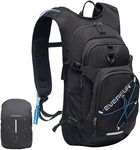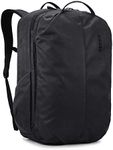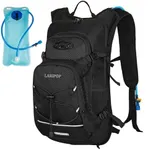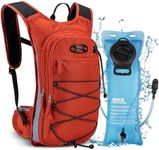Buying Guide for the Best Cycling Backpacks
Choosing the right cycling backpack can significantly enhance your riding experience, providing comfort, convenience, and safety. When selecting a cycling backpack, it's important to consider various factors that will meet your specific needs and preferences. Here are some key specifications to help you make an informed decision.CapacityCapacity refers to the volume of the backpack, usually measured in liters. This spec is important because it determines how much you can carry. For short rides or commutes, a smaller capacity (10-15 liters) is sufficient for essentials like a water bottle, snacks, and a repair kit. For longer rides or if you need to carry more gear, consider a medium capacity (15-25 liters). For multi-day trips or if you need to carry a lot of equipment, a larger capacity (25+ liters) is ideal. Choose a capacity based on the length of your rides and the amount of gear you need to carry.
Fit and ComfortFit and comfort are crucial for a cycling backpack, as an ill-fitting backpack can cause discomfort and even injury. Look for adjustable straps, padded shoulder straps, and a back panel that conforms to your body. Some backpacks also have waist and chest straps for added stability. Try on different backpacks to see which one feels the most comfortable and secure. Consider your body size and shape, and ensure the backpack distributes weight evenly to avoid strain.
Hydration CompatibilityHydration compatibility means the backpack can accommodate a hydration bladder, allowing you to drink water without stopping. This is important for staying hydrated on long rides. If you plan to ride for extended periods, look for a backpack with a built-in hydration system or one that has a dedicated compartment for a hydration bladder. The bladder size typically ranges from 1 to 3 liters. Choose a size based on how long you plan to ride and how much water you need.
Weather ResistanceWeather resistance refers to the backpack's ability to protect your gear from rain and other elements. This is important if you ride in varying weather conditions. Look for backpacks made from water-resistant materials or those that come with a rain cover. Some backpacks are fully waterproof, which is ideal for heavy rain. Consider the typical weather conditions you ride in and choose a backpack that offers the appropriate level of protection.
Storage and OrganizationStorage and organization refer to the number and type of compartments and pockets in the backpack. This is important for keeping your gear organized and easily accessible. Look for backpacks with multiple compartments, including a main compartment, smaller pockets for tools and accessories, and side pockets for water bottles. Some backpacks also have specialized compartments for laptops or tablets. Think about what you need to carry and choose a backpack with the right combination of compartments and pockets.
VentilationVentilation refers to the backpack's ability to allow air to flow between your back and the backpack, reducing sweat and heat buildup. This is important for comfort, especially on long rides or in hot weather. Look for backpacks with mesh back panels or ventilation channels. These features help keep your back cool and dry. If you tend to ride in warm conditions or for long durations, prioritize a backpack with good ventilation.
Reflective ElementsReflective elements are materials or designs on the backpack that reflect light, making you more visible to others, especially in low-light conditions. This is important for safety, particularly if you ride at dawn, dusk, or night. Look for backpacks with reflective strips, logos, or attachments for lights. If you frequently ride in low-light conditions, choose a backpack with ample reflective elements to enhance your visibility and safety.























